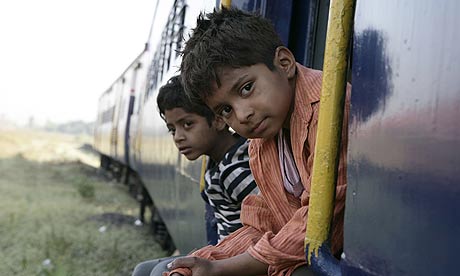Wednesday, December 5, 2012
Slumdog Millionaire
The film Slumdog Millionaire places its story of the common rags-to-riches frame of many fairy tales in the postcolonial global city of Mumbai. This story is told through the lens of persons born and raised in the poorest areas of Mumbai who have been most affected by the global economic and political practices set in motion by Western colonialism and imperialism. In many traditional folklores, the rags-to-riches fairy tale is extended in a brothers tale, in which two (or more) brothers strive for success, riches, and/or acceptance, but only one (usually the youngest) comes out on top. In Slumdog Millionaire, Jamal is the successful brother because he does, in a sense, “buy into” the system set in place by the globalized, postcolonial power structure. While the older brother, Salim, chooses to stick with gangs (those working outside the globalized system) for his survival, Jamal works in a call center (a standard example of a globalized service) and ends up going on a game show. Not only does he participate on a game show that is, in origin, British, but he does very well on the show by answering structured questions, several of which focus on Western or global topics. Through a series of flashbacks we learn that Jamal knows these answers from living in the East. He doesn’t need to have traveled outside India to know who is on the American one hundred dollar bill, or have been educated in a formal system to recognize Indian poetry, but simply having grown up at even the very lowest tier of postcolonial India has prepared him to know most of the answers. The film, then, places this narrative within the post-colonial context of a global city, and also seems to suggest that through this system comes success—whether that suggestion is made out of observation or critique.
In a film blog posted on the Guardian UK, Nirpal Dhaliwal discusses the reception of Slumdog Millionaire in India and argues with critics that the film is not a poor representation of India as a stereotypical developing city, but that it depicts India with a sort of warm truth that is very much ignored in mainstream Bollywood films. Dhaliwal claims, "Poor Indians, like those in Slumdog, do not constitute India's "murky underbelly" as Bachchan moronically describes them. They, in fact, are the nation. Over 80% of Indians live on less than $2.50 (£1.70) a day; 40% on less than $1.25. A third of the world's poorest people are Indian, as are 40% of all malnourished children. In Mumbai alone, 2.6 million children live on the street or in slums, and 400,000 work in prostitution. But these people are absent from mainstream Bollywood cinema." (The CIA World Factbook gives some similar numbers on the population, though some of Dhaliwal's numbers are unaccounted for.) Dhaliwal has titled his post "Slumdog Millionaire Could Have Only Been Made by a Westerner" not because he feels an outsider has a skewed perception of the nation, but because he thinks only an outsider would have the nerve to represent the struggling, still developing side of India that continues to live in poverty and outside the mainstream Indian media.
On the other end of the spectrum are those who objected to the film's representations of the poor in India. While some focused on the use of the derogatory name "dog" in the title, others were upset that the film continued to show to the world the same old poor, crime-filled India that it has always seen. These critics believe when the Western world watches the film they will see India as the villain standing in the way of the two young lovers; they claim the film does not accurately portray India because it focuses only on the slum Dharavi, but not on the middle class or upper class societies in India. While these critics have a point about the representation of India, one could argue that the point of the film is not to cast a representation of India as a whole nation (though it should be careful, as this is what it does for many Western viewers with no attachment to India), but to show the struggle of poverty in the country. The claims from the critics of the film seem to back up Dhaliwal's claim that many Indians would rather ignore the problems of the slums for As Dhaliwal claims, the people living in Indian slums are all but absent in the mainstream Bollywood culture, and Slumdog Millionaire attempts to show a success story for this walk of life. If, instead of the slums of Mumbai, this film were set in a middle class suburb this story would be even remotely the same, as their history of being born in a slum impacts every part of Jamal, Salim, and Latika's lives.
Subscribe to:
Post Comments (Atom)



Interesting and thoughtful discussion. Could be put in conversation with your post on *The White Tiger,* especially in relation to questions you raised about whether Adiga's portrait of poverty was accurate and whether an author/director must have direct, personal experience of poverty to represent it.
ReplyDelete